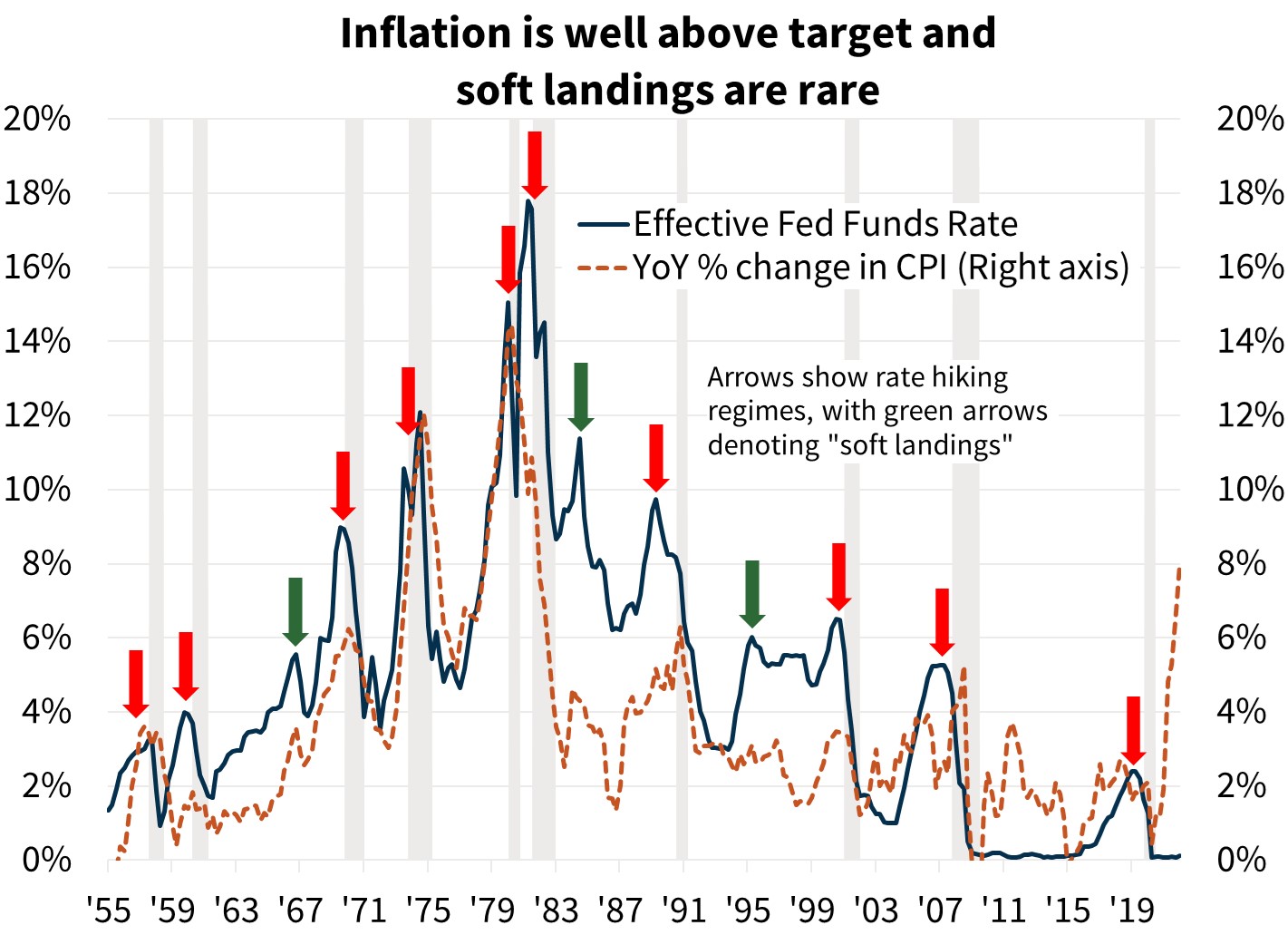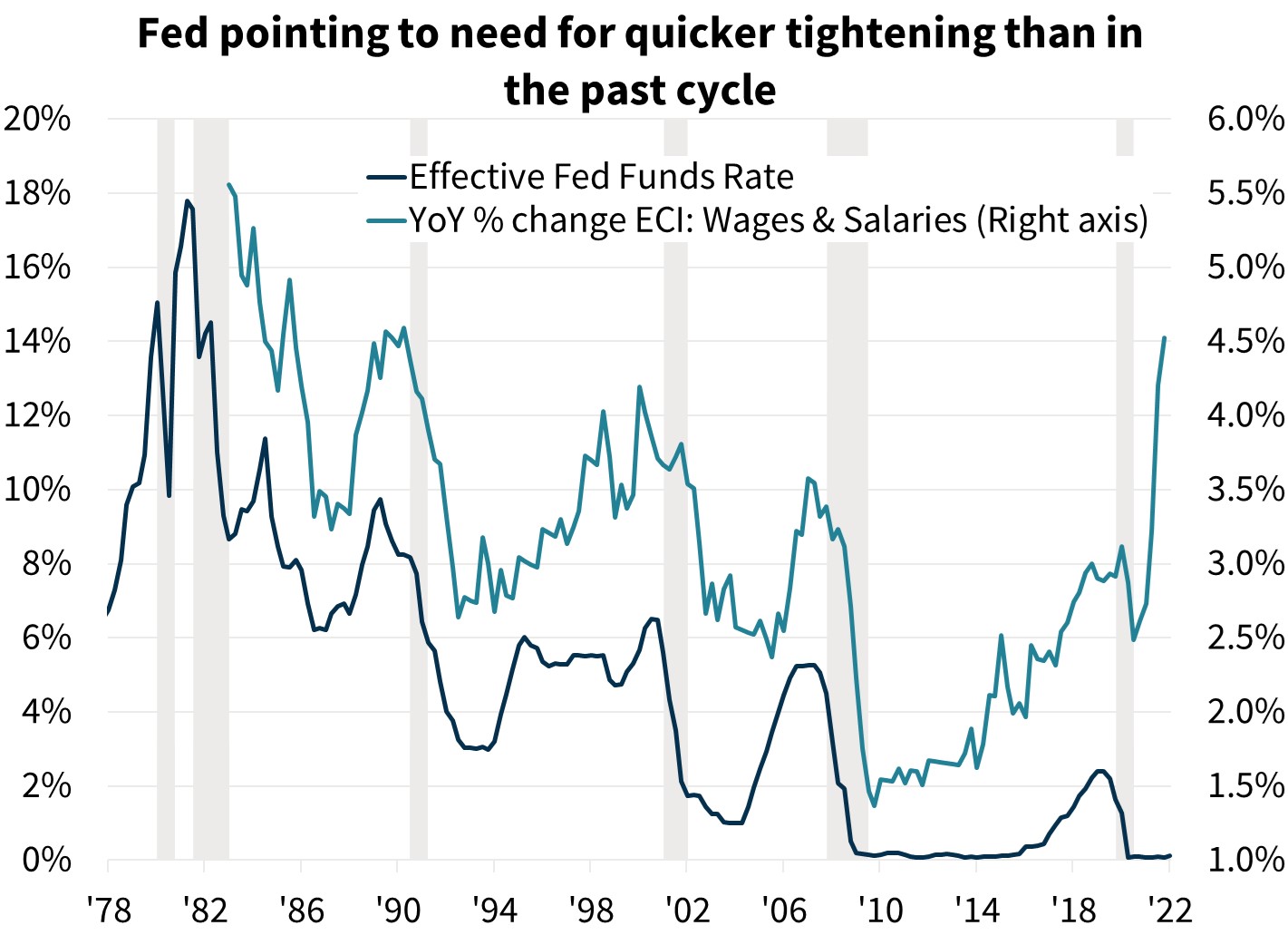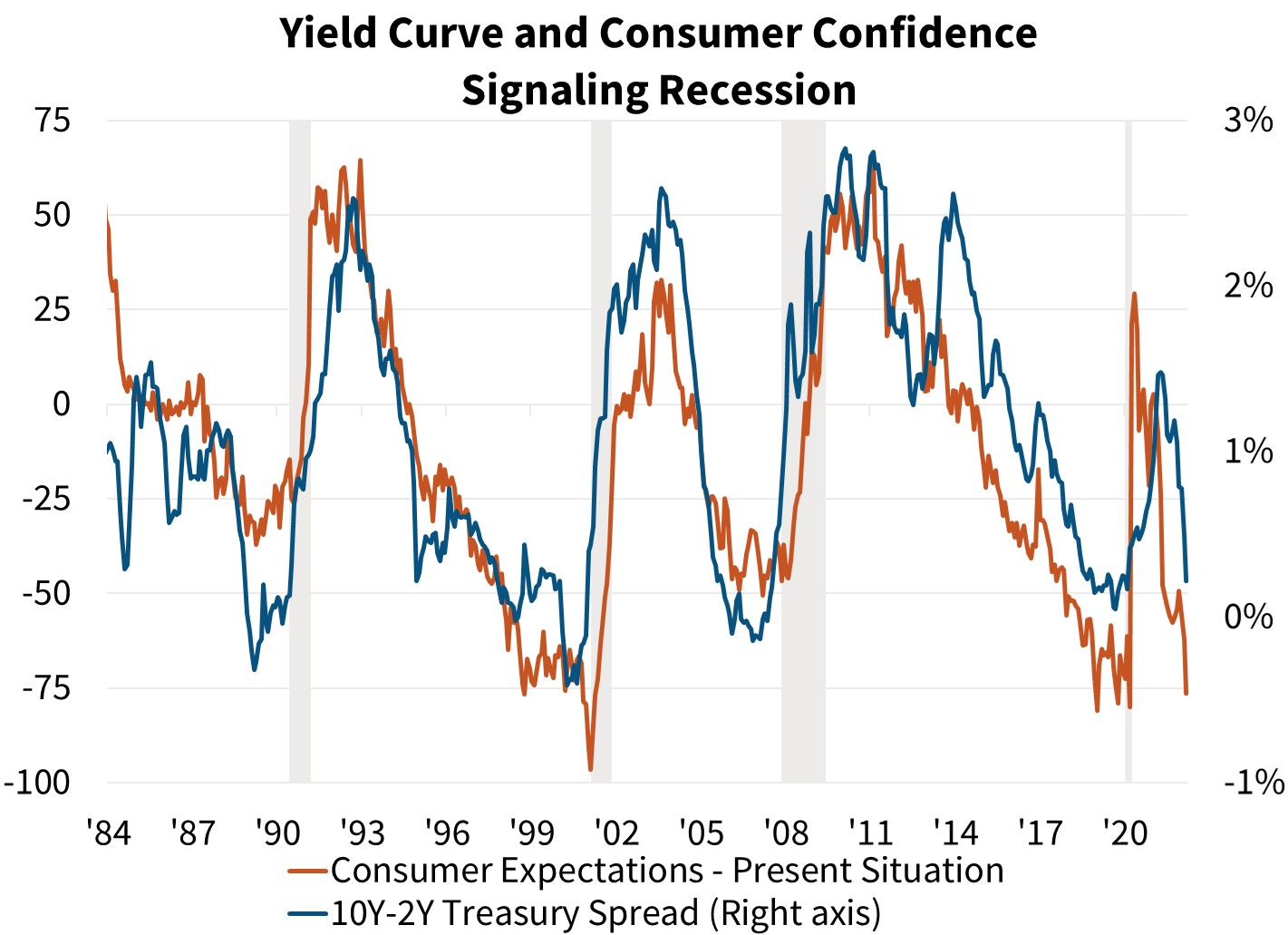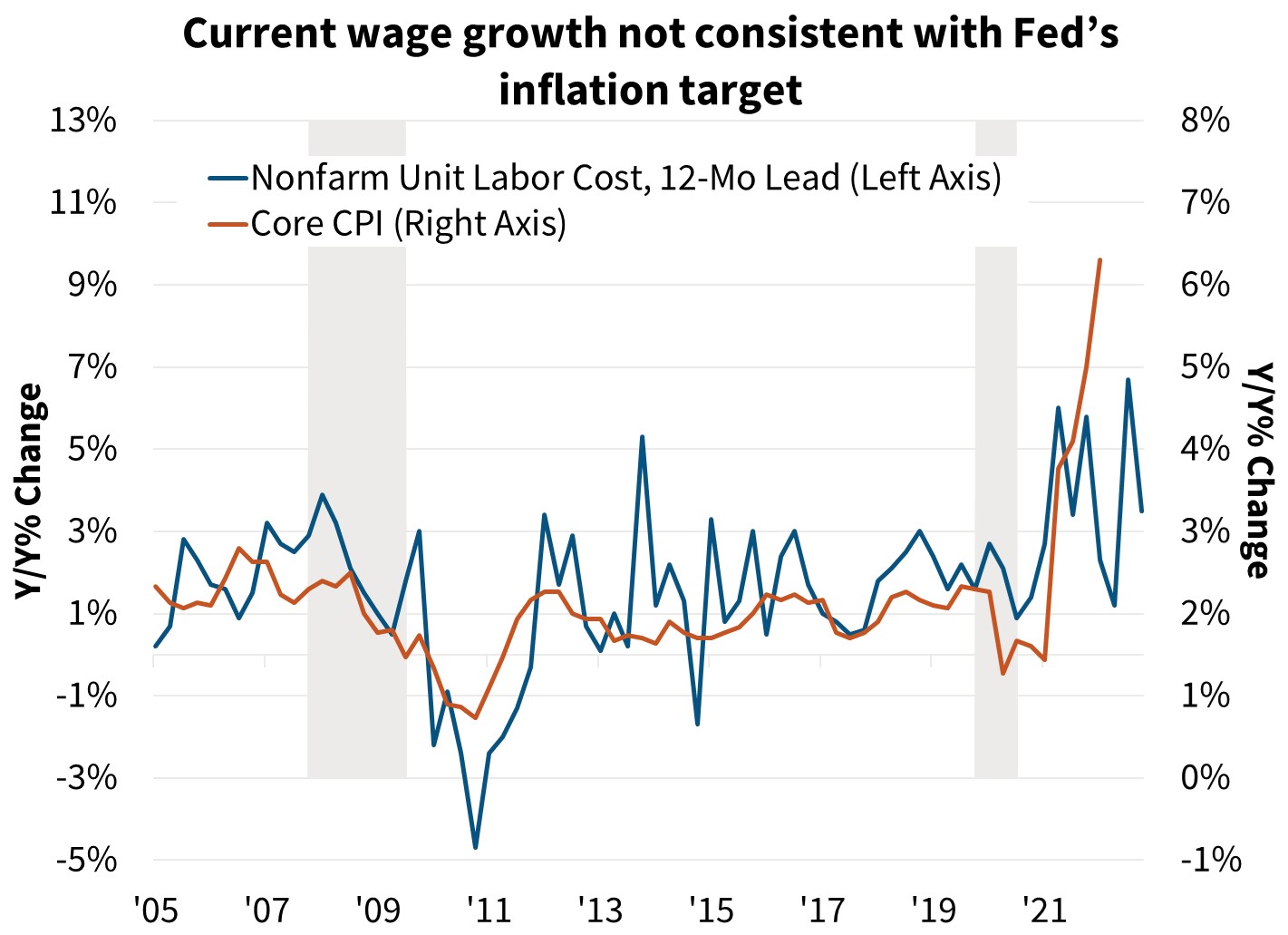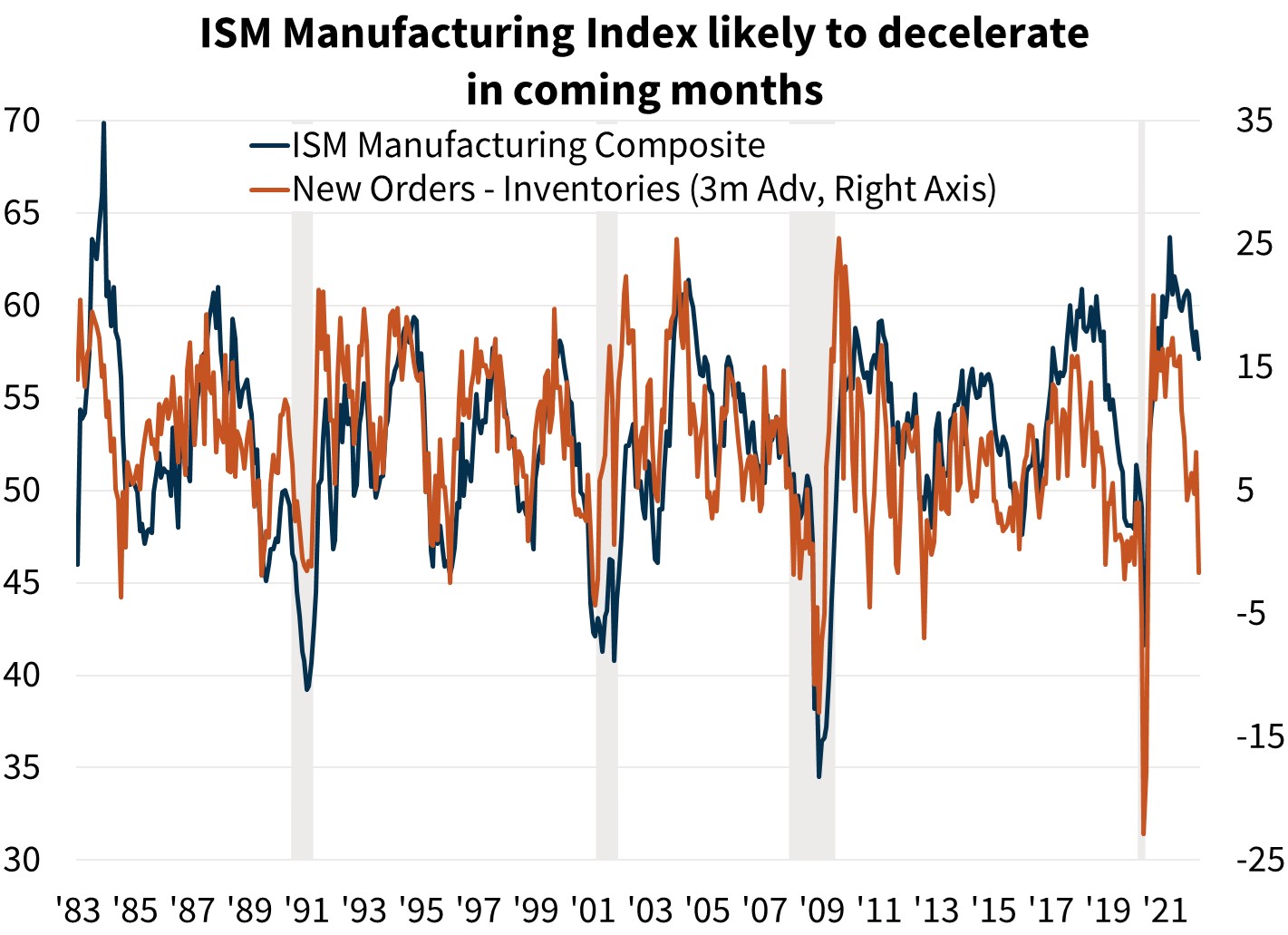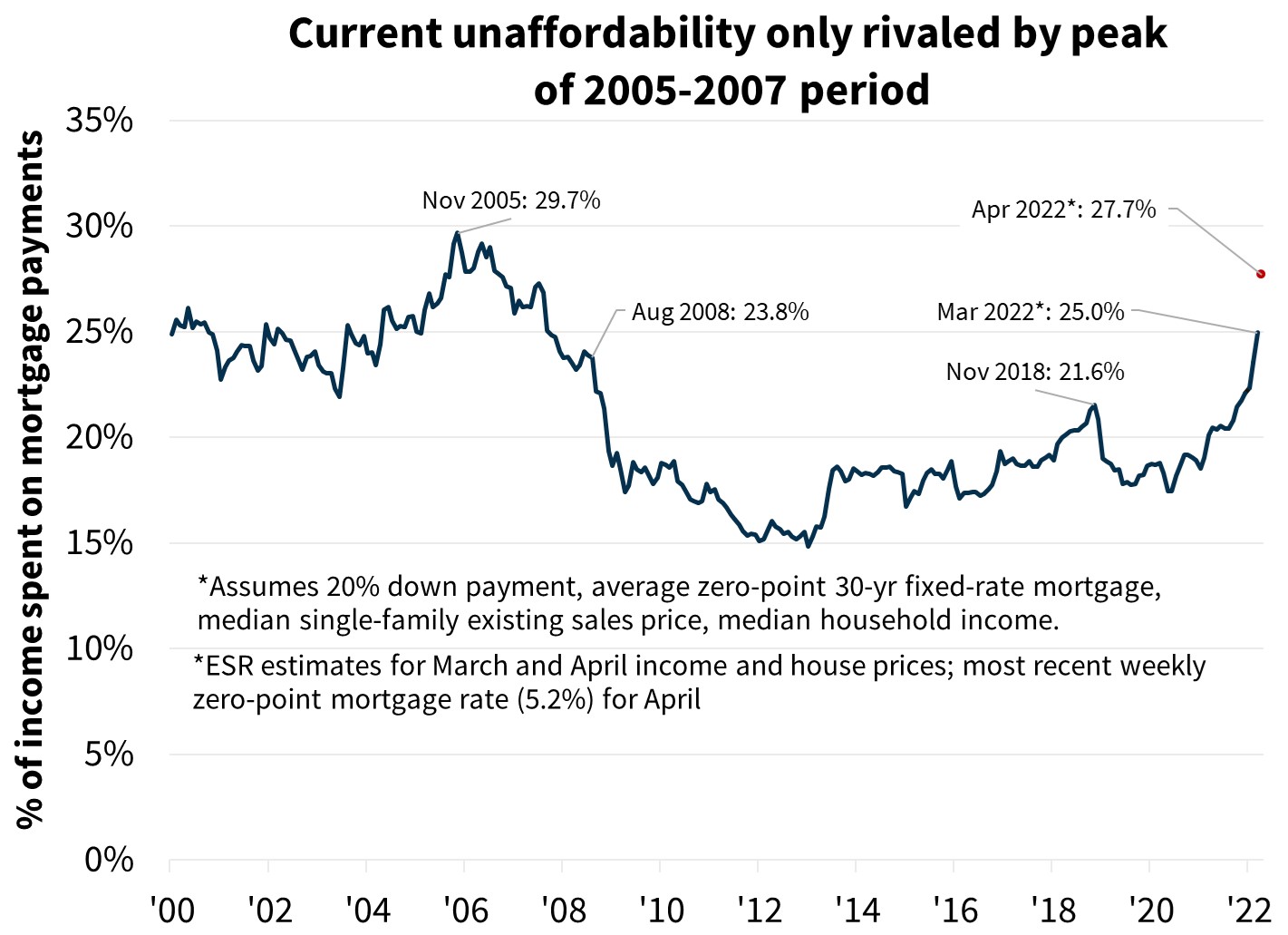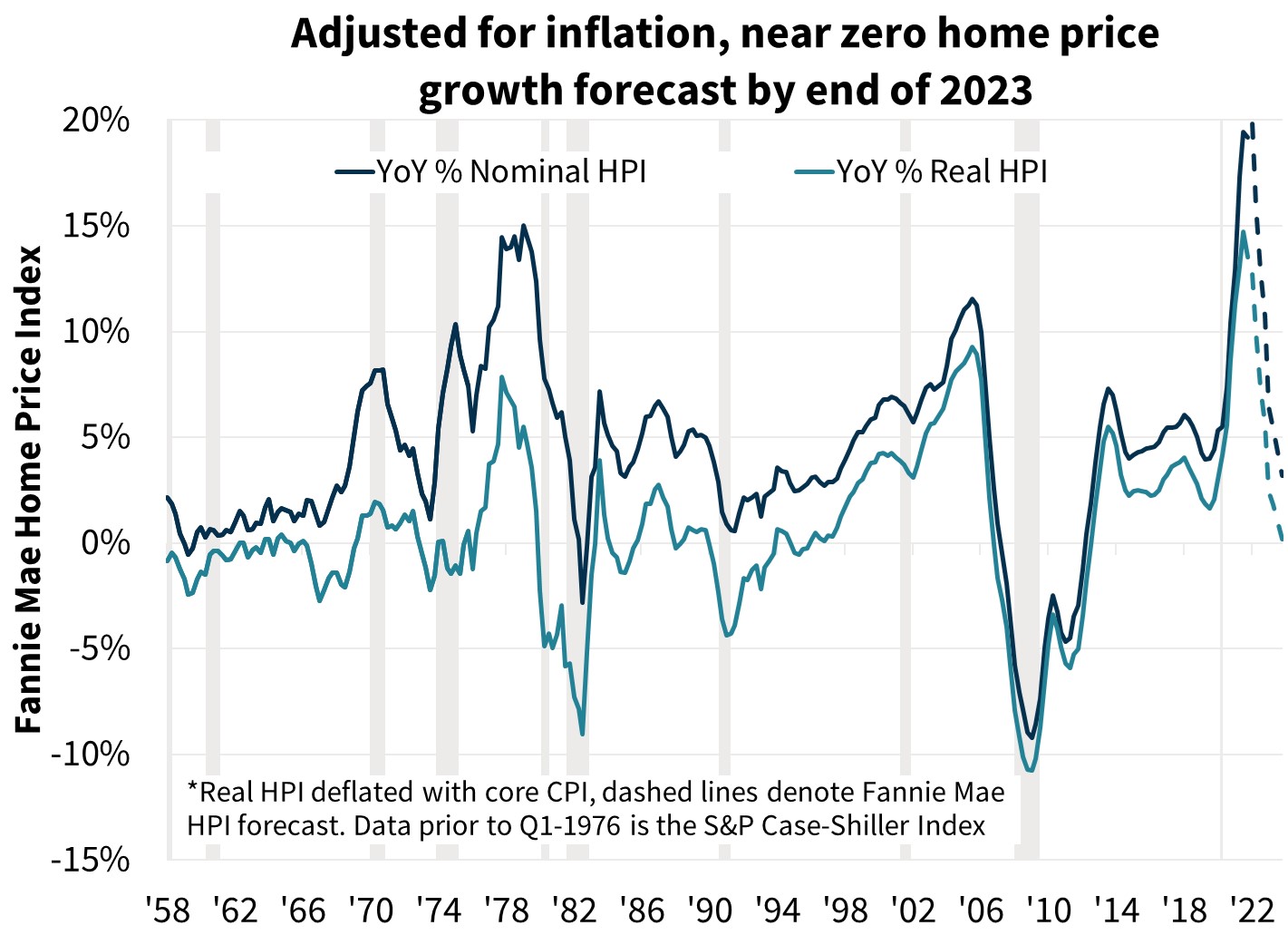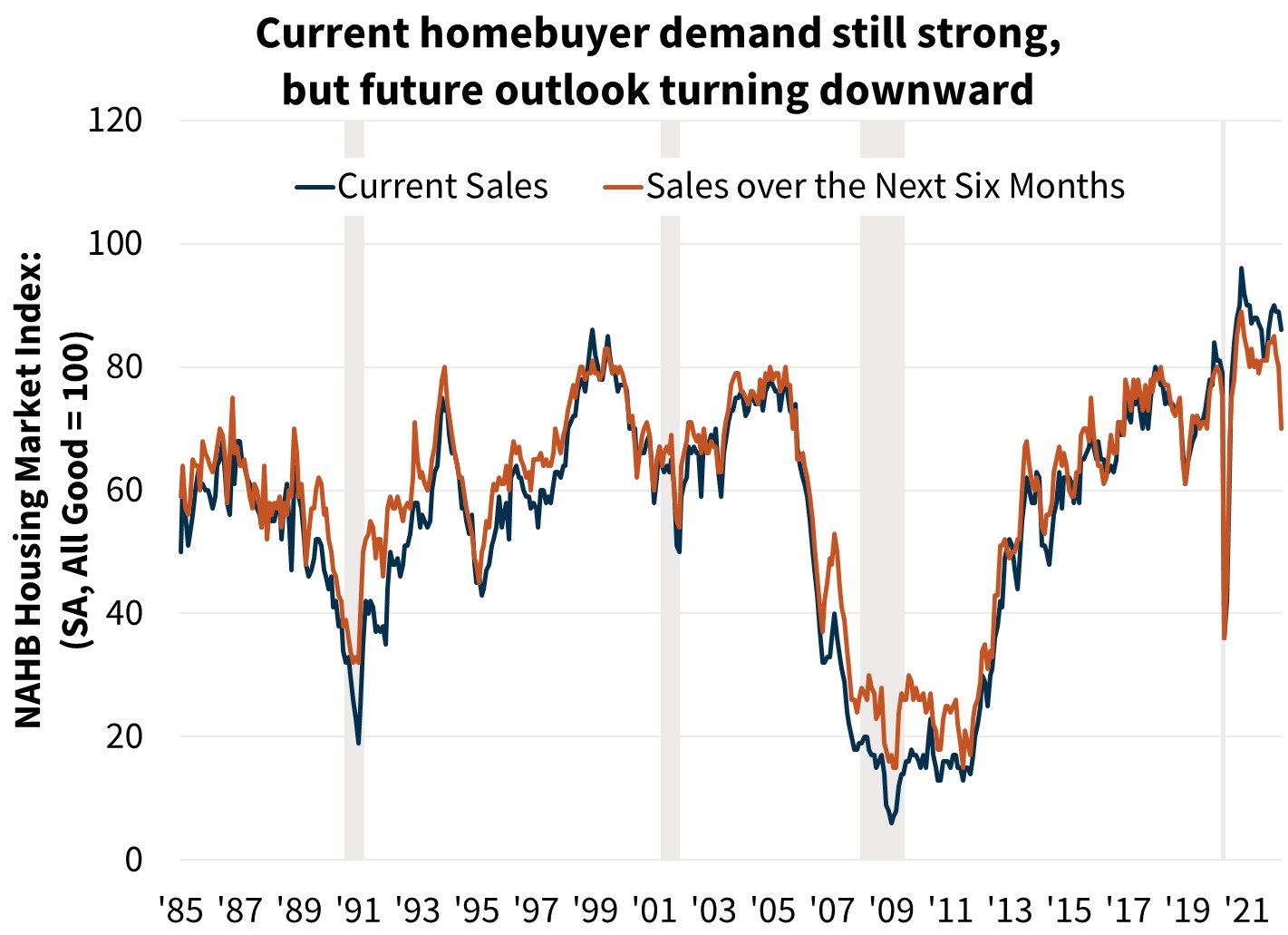Our updated forecast includes an expectation of a modest recession in the latter half of 2023 as we see a contraction in economic activity as the most likely path to meet the Federal Reserve’s inflation objective given the current rate of wage growth and inflation.
Since our last forecast, monetary policy guidance has shifted in a hawkish direction, and markets have responded with rapid increases in interest rates, signaling a belief that brisker tightening is likely to occur. While a “soft landing” for the economy is possible, which is where inflation subsides without economic contraction, historically such an outcome is an exception, not the norm. With the most recent inflation readings at levels not seen since the early 1980s and wage growth exceeding that which is consistent with a 2-percent inflation objective, we believe the odds of a soft landing are even lower. Returning to the Fed’s policy target, therefore, likely necessitates economic growth slowing sufficiently to lead to a rise in the unemployment rate, which would cool wage and price pressures.
We expect this to unfold in part via higher mortgage rates that lead to slower housing activity. We have downgraded our total home sales forecast for 2022 to a decline of 7.4 percent (previously a 4.1 percent decline) followed by a decrease of 9.7 percent in 2023 (previously a 2.7 percent decline). House price growth, as measured by the newly released Fannie Mae Home Price Index, is forecast to decelerate from the most recent reading of 20.0 percent annual growth in Q1 2022 to 10.8 percent growth by year end. We expect this to be followed by further deceleration in 2023 to 3.2 percent growth on a Q4/Q4 basis. We forecast single-family mortgage originations to total $2.8 trillion in 2022 and to total $2.4 trillion in 2023, down from our previous forecast of $3.0 trillion and $2.7 trillion, respectively. It should be noted that interest rates have moved up further than we had expected since the completion of our interest rate forecast at the start of the month, representing downside risks to our housing forecast.
While growing affordability constraints point to strong pressure for home prices to converge toward a more historically normal relationship to household incomes, we are not expecting the next recession to result in a 2008-like housing or financial crisis. Mortgage credit quality is far superior in the current period. Both residential real estate in aggregate and the mortgage finance system are far less leveraged now, and mortgage servicers and public policy are better equipped to deal with delinquencies and to provide loan modifications or other home preservation strategies as needed. There also continues to be a long-running undersupply of homes available relative to demographic demand, and we therefore expect new home construction to play a leading role in the eventual recovery.
The Economy This Year and Next
We have modestly downgraded our 2022 real gross domestic product (GDP) forecast by 0.2 percentage points to 2.1 percent on a Q4/Q4 basis, still above the Fed’s view of the longer-term potential growth trend. We continue to see ample demand drivers in the near term, even though higher interest rates and the ongoing effects from the Russian invasion of Ukraine will likely weigh on growth. Record-high job openings also point to near-term resilience as the year unfolds. The larger change is a downward revision to our 2023 GDP growth forecast from 2.2 percent to negative 0.1 percent, reflecting our projected economic contraction. Our outlook through 2023 is consistent with the unemployment rate topping out at approximately 6 percent at some point in 2024. Such a change from the current unemployment level would be similar in magnitude to the 1990 and 2001 recessions.
Inflation, as measured by the Consumer Price Index (CPI), is forecast to have peaked in March on an annual basis at 8.5 percent (though not necessarily m/m changes) with future deceleration reflecting stronger annual base effect comparisons from 2021, expected price stabilization in energy, and declines in auto and some other durable goods prices. Still, inflation is expected to remain elevated, averaging 5.5 percent in Q4 2022. The Fed’s preferred inflation measure, the core PCE deflator, is forecast to be 4.3 percent by the end of the year, before slowing to 2.8 percent by the end of 2023 as economic activity also slows.
In the near term, our forecast assumes that oil and auto prices have leveled off and will limit topline inflation for the rest of the year, leading to a stabilization in real incomes, which are now declining. If this does not materialize, given that the savings rate is below pre-COVID norms, and consumer confidence is at depressed levels, consumers may cut back on spending more rapidly than we expect, leading to lower than projected economic activity. It is also possible that the degree of rate hiking to unfold is greater than we currently expect, or that inflation is more resilient than we currently believe, leading to a deeper eventual downturn. As discussed in detail in our last commentary, there are also ongoing risks regarding the Russian invasion of Ukraine and COVID-related lockdowns in China. Alternatively, plausible scenarios also exist in which inflationary pressures from supply chain backlogs and oil prices ease sufficiently over the coming quarters such that a more gradual pace of rate hiking is made possible. In this case, a recession may be avoided. Additionally, if more workers enter the labor force than we currently are expecting, this will also help alleviate some of the wage pressure contributing to inflation while sustaining higher GDP growth.
Why a Recession Call Now?
We have previously posited that the current business cycle would likely be shorter than those of the past few decades. GDP growth surged in 2021 after the relaxation of many COVID restrictions – also supported by historic income transfers and monetary policy easing – which led to a swift recovery but also planted the seeds of inflation. Therefore, despite only two years having passed since the COVID-driven recession of 2020, the economy has already moved into what could be described as the mature stage of the business cycle. Specifically, the unemployment rate is below the “full employment” level, inflation is accelerating as growth slows, and the Federal Reserve is beginning to tighten policy. These conditions typically mark the beginning of the end of an economic expansion.
We believe enough has now changed over the past couple months to expect this eventual downturn by the end of 2023. The Fed has shifted its guidance in a strongly hawkish direction and is essentially communicating that policy is behind the curve and needs to catch up. The minutes released from the March meeting indicated that uncertainty over developing events in Ukraine preempted members from taking a more aggressive rate hike approach.
Details also revealed that the Fed’s balance sheet runoff was planned to occur at roughly twice the speed as had been done previously in 2017-2018. Multiple Fed officials have also made recent comments on the need to “expeditiously” bring the fed funds rate above the long-run “neutral rate,” the level that neither stimulates nor slows the economy. Historically, once a committed policy of rate hiking begins, a recession usually follows, albeit with varying time lags. There have only been three “soft landings” in post-World War Two history, and they have all occurred when the Fed was preemptive about hiking rates before high inflation took hold. Therefore, while possible, avoiding a downturn upon completion of a rate-hiking regime has been the exception rather than the rule, and we believe it is more unlikely because inflation is already running greatly above the Fed’s target.
Though it has since steepened, the recent inversion of much of the Treasury yield curve also points to a downturn occurring. Historically, the inversion of the 2-10 portion has been one of the more reliable leading recession indicators. There is debate over whether this is as strong a signal now as it’s been in the past given quantitative easing pushing down longer-term bond yields and potentially distorting this indicator. The yield curve, however, is not the only measure pointing in this direction. The spread between current and future expectations in the Conference Board’s consumer confidence surveys is highly correlated to the 2-10 yield curve, and recent readings of the former are corroborating recent moves in the latter. Therefore, while it is possible that the yield curve inversion is indeed a false alarm, we think it prudent to not discount this indicator in our baseline outlook.
Additionally, while much of current inflation is driven by commodities and durable goods affected by supply chain disruptions, there is also growing underlying inflation pressure related to labor market dynamics. The Atlanta Fed wage tracker, which controls for job types, is showing wage growth over 6 percent annually, far ahead of what is sustainable given current productivity growth. While the data are noisy, the recent trend in unit labor costs, a measure of the price of an hour of labor relative to the value of output, is consistent with an underlying core CPI inflation rate of 3.0 to 3.5 percent and may be rising given recent wage measures. If not curtailed, there is risk of long-run inflationary expectations rising, leading to a self-fulfilling and lasting heightened level of inflation. To prevent this, the Fed’s more hawkish guidance implies a willingness to cool labor demand sufficiently to slow wage growth.
And Why 2023?
Assuming no further jump in oil prices or major worsening of global supply chain issues occurs, we do not expect a contraction in the near term. Monetary policy acts with a lag before impacting real activity. Furthermore, there is a continued need for firms to rebuild inventories, likely pent-up demand for auto sales given supply disruptions over the past year, and near-term business capital expenditures look to be strong. These should help drive demand growth in the near term even as overall consumer spending is expected to soften this year. In the short run, job openings greatly exceeding the total number of unemployed also suggest that the labor market will be able to absorb a significant cooling in demand without significantly reducing total employment.
However, historically no meaningful deceleration in wage growth, which we believe is needed to dampen inflation to the Fed’s target, has occurred without the unemployment rate rising above the non-accelerating inflation rate of unemployment (or NAIRU). Based on the Congressional Budget Office’s 4.5-percent estimate for NAIRU, this would require a rise in the unemployment rate of over 1 percentage point from the projected near-term low. A move of such magnitude has never happened without a recession occurring. For the unemployment rate to rise, GDP growth must slow to a pace below trend growth. At this speed, avoiding an outright contraction is a very difficult monetary policy balancing act to sustain given the time delay between policy changes and realized effects, as well as lagged incoming data. It also leaves the economy vulnerable to being knocked off course by unexpected shocks.
For indications of likely timing, again we have placed significant weight on the recent inversion of the 2-10 Treasury yield curve. Historically, recent downturns occur between 3 and 11 quarters after the event, which would place a central tendency in late 2023. This is also consistent with the Fed’s “dot plot” anticipating a terminal fed funds rate being achieved some time next year, as well as current Treasury forward curves anticipating rate cuts to begin in early 2024, which may signal an expectation of a downturn. While it remains at an elevated level, the ISM Manufacturing Index, which has a long track record of measuring general growth trends, is expected to make further declines this year based on movement in the internal components and past relationships to global monetary policy tightening. This points to sub-trend growth, if not an outright decline, occurring in 2023.
Housing This Year and Next
Recent mortgage rate rises (now up 196 basis points from a year ago to 5.0% in the latest Freddie Mac weekly survey) are suggesting that housing activity will soon slow. House prices continue to grow at a historically high pace, up around 20 percent in Q1 2022 on an annual basis, as measured by the newly released Fannie Mae Home Price Index. With mortgage rates rising swiftly in recent months, affordability has diminished greatly. As measured by the share of median household income needed to purchase a median-priced home with a 30-year fixed-rate mortgage, affordability has only been worse in the 2005-2007 period. Combined with an increasing share of current mortgage borrowers having significant “lock-in” incentives, meaning they are currently paying lower rates than they could borrow at on a new home, we expect both home sales and home price growth to decelerate considerably this year. A meaningful decline in home sales often points toward downturns in economic cycles, as housing is interest rate sensitive and usually leads general turns in the economy. Additionally, adjusted for inflation, our forecast for house price growth approaches zero percent in real terms by the end of 2023, something that has also only occurred in or near recessions.
Higher Mortgage Rates Will Slow Housing
As we discussed in prior commentaries, the high degree at which home sales have faced bidding wars over the past year suggests that sales will initially be resilient in the face of mortgage rate increases due to an excess pool of buyers being available who were previously outbid or couldn’t find an appropriate home. We expect this group will help maintain sales in the near term but with fewer bidding wars. We continue to believe this dynamic to be true, but the speed at which mortgage rates are rising makes this less relevant than we had previously expected. At 5.0 percent, according to Freddie Mac, mortgage rates have risen 1.95 percentage points since the recent low in mid-December, the fastest increase for such a time interval since 1980. Despite the magnitude of the change being lesser, similarly rapid rate increases in 2013 and 2018 led to significant slowdowns in home sales.
A principal and interest payment using a 30-year mortgage on a median-priced home has risen by about 30 percent since December based on rates and estimated house price gains. This is likely to force out many potential buyers. Additionally, higher rates have greatly increased “lock-in” effects. By our estimation roughly 80 percent and 65 percent of outstanding first lien mortgages have a note rate at least 50 and 100 basis points lower than current market rates, respectively. For a borrower who has recently purchased or has refinanced into a 30-year loan over the past couple of years, purchasing a new home even with the same sized mortgage would result in a large increase in mortgage payment, a strong disincentive to do so. We are now expecting existing home sales to fall more sharply in coming quarters, down 8.6 percent for 2022 compared to 2021.
We expect new home sales and single-family housing starts to remain comparatively resilient in the near term, in part due to a heightened level of homes currently under construction and high order backlogs. Additionally, most publicly traded homebuilders report considerably higher gross margins recently than what is typical, suggesting that even with some price softening relative to input cost growth, builders will be willing to supply more homes. While the lack of existing homes for sale will still support new home demand, the above-mentioned “lock-in” effect and worsening affordability will eventually weigh on new sales as well. The most recent reading of homebuilders’ sentiment showed continued strong current expectations for sales, but the index fell sharply for the six-month outlook. While the level was still elevated, indicating good market conditions, the change was one of the largest in series history. We forecast new home sales and starts to soon peak but remain elevated before declining more meaningfully into 2023.
Regarding home prices, while we are forecasting strong annual gains of 10.8 percent this year on a Q4/Q4 basis, we estimate that the bulk of this rise will occur in the first half of the year. This annual projection implies a sharply decelerating Q/Q home price growth path that continues into 2023. Given that the national average is projected to decelerate to just 3.2 percent annual by year-end 2023, and that house price growth varies by geography, this implies that some regions will likely experience outright house price declines next year.
Higher interest rates and a slowing economy would also weigh on multifamily construction, but in part due to longer time leads on construction projects, multifamily construction activity tends to coincide with economic cycles rather than lead them. We expect multifamily starts to weaken comparatively less through 2023. But as is the case with single-family homes, we believe the long-run need for more housing units will continue following the next downturn.
Mortgage Originations Revised Downward
Total mortgage originations are projected to be $2.8 trillion in 2022, down from $4.5 trillion in 2021, with the refinance share of dollar volume expected to fall from 58 percent last year to just 32 percent this year. On the purchase side, mortgage originations are expected to total $1.93 trillion in 2022 and $1.85 trillion in 2023, both downward revisions from last month’s forecast. These revisions are driven by multiple offsetting considerations. To begin with, we have upgraded our expectation for home prices due to stronger-than-expected Q1 2022 home price growth, leading to an increase to our purchase volume forecast. However, outweighing this are the downward revisions to our home sales outlook. Overall, purchase volumes in 2022 and 2023 are expected to be $18 billion and $130 billion lower, respectively, than we’d previously forecast. Purchase mortgages are not expected to decline as greatly as home sales; however, given our expectation that economic stress will take hold in the second half of 2023, we expect the cash share of transactions to fall slightly as investors take a step back from the market.
Our forecast for refinance originations also has sizeable changes relative to last month, driven by the significantly higher mortgage rate forecast given the recent run-up in rates. We now expect $889 billion in refinance volumes in 2022, $148 billion lower than last month. In 2023, we expect volumes to decline to $558 billion, as the higher interest rate forecast drives further declines. These expected volumes in 2023 are of a similar level to volumes seen in 2018, when the average interest rate was around 4.5 percent. With the current mortgage rate at 5.0 percent in the latest reading, we estimate that just 2.3 percent of all outstanding loan balances have a refinance rate incentive of at least 50 basis points.
Economic & Strategic Research (ESR) Group
April 14, 2022
For a snapshot of macroeconomic and housing data between the monthly forecasts, please read ESR’s Economic and Housing Weekly Notes.
Data sources for charts:Bureau of Labor Statistics, Federal Reserve, Conference Board, Federal Reserve Bank of Atlanta, Congressional Budget Office, Institute for Supply Management, National Association of REALTORS®, S&P Case-Shiller, Fannie Mae, National Association of Home Builders
Opinions, analyses, estimates, forecasts and other views of Fannie Mae’s Economic & Strategic Research (ESR) Group included in these materials should not be construed as indicating Fannie Mae’s business prospects or expected results, are based on a number of assumptions, and are subject to change without notice. How this information affects Fannie Mae will depend on many factors. Although the ESR group bases its opinions, analyses, estimates, forecasts and other views on information it considers reliable, it does not guarantee that the information provided in these materials is accurate, current or suitable for any particular purpose. Changes in the assumptions or the information underlying these views could produce materially different results. The analyses, opinions, estimates, forecasts and other views published by the ESR group represent the views of that group as of the date indicated and do not necessarily represent the views of Fannie Mae or its management.
More From The Real Estate Guys…
- Check out all the great free info in our Special Reports library.
- Don’t miss an episode of The Real Estate Guys™ radio show. Subscribe on iTunes or Android or YouTube!
- Stay connected with The Real Estate Guys™ on Facebook, and our Feedback page.
The Real Estate Guys™ Radio Show and podcast provides real estate investing news, education, training, and resources to help real estate investors succeed.
Subscribe
Broadcasting since 1997 with over 600 episodes on iTunes!
Love the show? Tell the world! When you promote the show, you help us attract more great guests for your listening pleasure!


